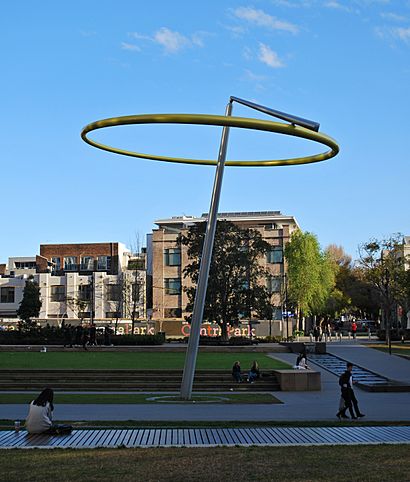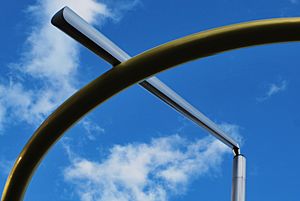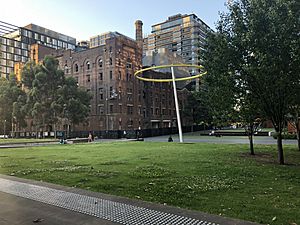Halo (sculpture) facts for kids
Quick facts for kids Halo |
|
|---|---|
 |
|
| Artist | Turpin + Crawford Studio |
| Year | 2012 |
| Type | Kinetic sculpture |
| Dimensions | 13 m × 12 m × 12 m (43 ft × 39 ft × 39 ft) |
| Location | Chippendale Green, Chippendale, Sydney, New South Wales |
Halo is a cool wind-powered kinetic sculpture in Sydney, Australia. A kinetic sculpture is a type of art that moves.
You can find Halo at Central Park. This artwork is part of a big project to build new homes and shops where an old brewery used to be.
Two artists, Jennifer Turpin and Michaelie Crawford, from Turpin + Crawford Studio, designed Halo. An engineering company called Partridge helped build it.
The sculpture has a large yellow ring, about 12 metres wide. This ring is held by a silver arm that is about 6-metre-long (20 ft). The arm sticks out and can move around a central point. It sits on top of a tall silver pole, which is about 13-metre-high (43 ft).
The arm also works like a sail. This means the wind can push it, making the ring turn and tilt. This movement shows how the sculpture reacts to the wind.
The companies building Central Park asked for Halo to be made, working with the local city government. Halo was officially opened on 14 August 2012. It has since been given to the City of Sydney to be part of their public art collection.
Contents
How Halo Was Designed
The Idea Behind Halo
The artists got their ideas for Halo from the old brewery that used to be on the site. The big round shape of Halo looks like the huge circular brewing vats that were in the old brewery building.
The way the ring moves in circles, off-centre, is like the stirring of ingredients when making beer. It also reminds people of the fun, wobbly feeling you might get from alcohol.
The design of Halo is very simple, which is called minimalist. Because it moves with the wind, it creates a calm feeling. This is special in a busy city area. The artists wanted their work to "collaborate with nature."
How Halo Was Engineered
The parts of Halo are made from a strong, light material called carbon fibre. These parts are joined together with stainless-steel connections.
The speed and tilt of the ring depend on how strong the wind is. Engineers did many tests, including in a wind tunnel, to make sure the sculpture would be strong and stable in real wind conditions. They wanted to use as little material as possible.
An engineer named Arran Gordon designed a special part called a bearing unit. This unit uses a tiny ceramic ball, only 12mm wide. This ball helps the ring move almost without any friction. It also balances the whole weight of the ring and arm.
Thanks to this design, the sculpture can start swaying even in very light winds, as slow as 2 km/h. The unit is also built to handle very strong winds. It has brakes that can slow down and control the movement when the wind is very strong.
The Shiny Finish
The artists wanted Halo's surfaces to have a special glow. They put a reflective, pearl-like glaze on the parts of the sculpture. They did a lot of research and testing with a colour expert to get this perfect look.
Building Halo
The carbon fibre ring and arm were made and painted at a boat building yard in Nowra. The whole sculpture was put together and tested there to see how it moved in the wind. After testing, it was taken apart so it could be easily moved.
The ring was made in three separate pieces. These pieces were put back together and connected to the arm and the special bearing unit. Finally, all the assembled parts were lifted onto the tall mast.
It took three years to research, design, and build Halo. It was finished in July 2012 and officially opened on 19 August 2012. The sculpture cost $1.3 million. This money came from the companies developing Central Park, Frasers Property Australia and Sekisui House Australia, working with the City of Sydney.
Awards for Halo
The Institution of Engineers Australia gave an award to Halo and the engineering company Partridge. They won the President's Award at the 2012 Engineering Excellence Awards Sydney. This award was for their new and clever ways of managing, designing, and building the sculpture.




